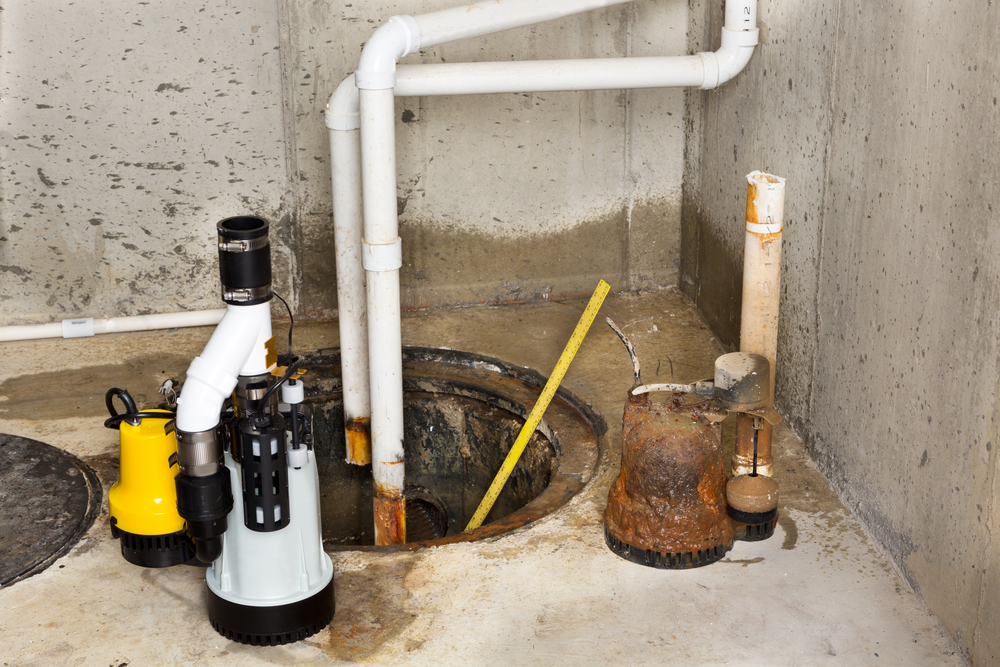Sump Pump Check: 5 Things to Check to Avoid Water Damage

Prevent Water Damage With Sump Pump Check-Ups
April showers bring May flowers! Spring is right around the corner, and with it comes the rainy season. While all the rain is great blooming spring flowers, it is not so good for our basements and crawl spaces.
All of this rain greatly increases the odds of basement flooding, even if you don’t live in a flood plain. According to the National Flood Insurance Program, floods are the No. 1 disaster in America, averaging over $3 billion in claims per year.
Repairing flood damage can be extremely costly depending on the extent of water entering your home.
So, what should you do to avoid coming home to knee-deep water in your basement?
Perform regular tests and maintenance of your sump pump! To test your pump all you need is a 5 gallon bucket and some water.
Test the Sump Pump
Make sure your sump pump is plugged in and slowly pour water into the hole where the pump is sitting. When the water caused the float to rise the pump should turn on and begin pumping out the water.
If your pump does not have a float, you can expect the pump to turn on when the water level is roughly 8-12 inches from the top of the floor.
Watch It Pump
Let your sump pump run until the water is low enough to turn off the pump, then fill it up again to make sure it turns on again.
Related Read: Looking for a 24-Hour Plumber in Cincinnati?
Check the Float
If your sump pump didn’t turn on, you may have a problem with your float. Make sure it is not stuck or rubbing against the side of the sump pump pit. The float is what triggers the on/off switch, so if it cannot move freely, it may be why your sump pump won’t turn on.
Try raising the float by lifting it up by hand to see if the pump turns on, or add more water to the sump basin until the float becomes activated. If the pump still does not operate you may have a bigger issue at hand.
Check the Outlet Pipe
Look for the outlet pipe on the outside of your home. This pipe should be directed away from your foundation to carry the water from your basement out, and away from your home.
Check for any clogs, buildup, or debris that would prevent a steady flow of water. You should also check for any obvious signs of damage that would require a repair. Water should be flowing freely and should not run back toward your home.
Consider Age and Condition of Sump Pump
Sump pumps usually have a lifespan of 10 years or so. With the weather we have in Cincinnati, there is a good chance that your sump pump gets a regular workout.
If your sump pump is over 10 years old, or is completely rusted over and ancient looking, there is a good chance you are on borrowed time. Even if it is working, plan to have it replaced soon so you don’t have a failure at the worst possible time.
What Else Can You do to Reduce Flood Risk to Your Home?
- Install a Battery Backup: With heavy storms, there is always a good chance your power may go out. Your sump pump runs on electricity so if the power goes out, your sump pump cannot pump water out of your basement. Sump pump battery backup systems are available and they allow your sump pump to operate even if the power is out. If your sump pump loses power a battery backup pump may just be the saving grace you need to keep your home dry.
- Check your gutter system: Rain gutters should be free of debris and cleaned regularly too allow water to flow away from your foundation. Additionally, you can consider purchasing gutter extensions which will attach to your down spouts to carry water further from the base of your home.
- Waterproof the walls: You can help to limit the amount of water that can enter your basement by plugging gaps and lining the walls. Your local hardware store will sell a waterproofing/sealing paint that you can add to increase the likelihood your walls will keep water out.
I’ve Had Water Damage, Now What?
- Contact your homeowners insurance immediately to see if you qualify for any coverage. Take extensive photos of the damage if necessary.
- To help keep costs of repairs low, the next step to take is to dry out the basement. If you’re dealing with standing water left on the floor, consider renting a wet vac to suck up and dispose of the remaining water.
- A dehumidifier will to help dry out the rest of the basement and reduce the occurrence of mold.
- Contact your plumber to rectify the problem so it does not happen again.